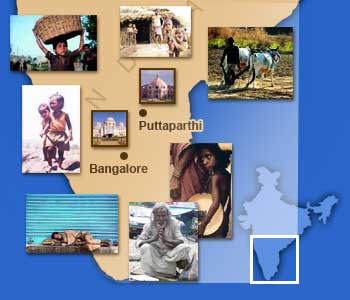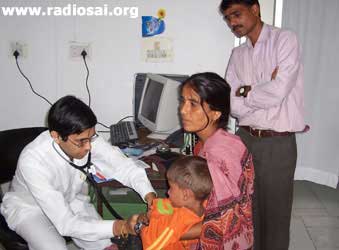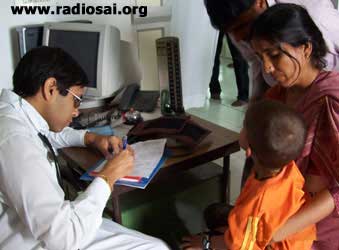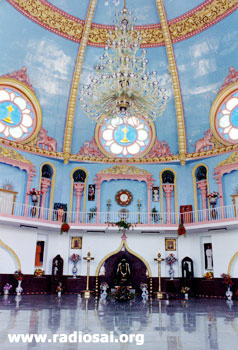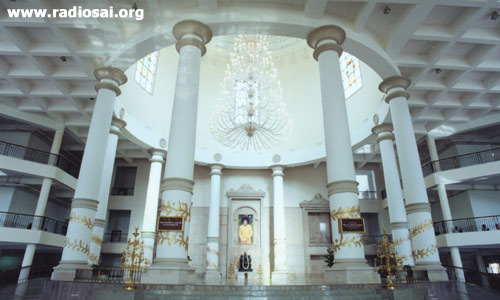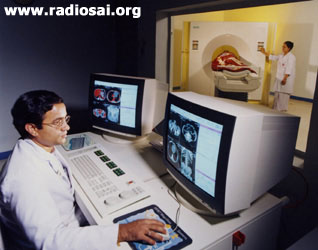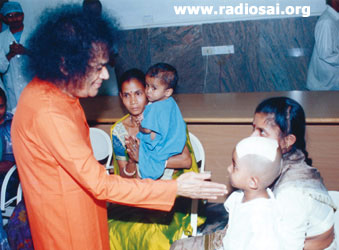 |
 |
 |
Volume
5 - Issue 08
AUGUST 2007 |
|
Spiritual activism – solution to modern healthcare woes By Mrs. Karuna Sarup-Munshi
As citizens of a first-world nation, all Canadians enjoy access to a universal healthcare system. While our wealthy friends south of the border depend on private insurance to cover their hospital, diagnostic and drug expenses, the Canadian constitution assures each of us access to doctors and treatment by the virtue of our citizenship or permanent residence. Our tax dollars are directed to ensure equitable and accessible medical care, a privilege often taken for granted by many. Lopsided Development Despite the stronger muscle of the US economy, American law makers have repeatedly debated the issue of universal healthcare but the political will and vision to legislate it through the road blocks set up by private healthcare lobbyists and vested interests remains weak and dismal. Opponents of the idea point to the enormous economic burden it will place on the federal and state budgets and the possibility that its universal access will dilute the quality and efficiency of the medical facilities that are available for payment under the current system. When it is a question of one’s health, no one minds paying, they argue, for speedy and effective treatment.
While Americans pride themselves in their world-class surgeons who offer state-of-the-art diagnostic services, even if for payment by private insurance companies, Canadians boast of the universal access to their healthcare system by all its citizens, be it a millionaire or a homeless person.
In the daily workings of the Sathya Sai healthcare system, spiritual activism finds its voice as the ultimate equalizer of opportunity to serve and be served, bringing to full circle the cyclical rotation of the “isms” of political and social systems. The playing field is level for all, be it the healthcare providers, hospital administrators, volunteer chaperones or patients who represent India ’s cultural, religious and social diversity. People from far-off places come here seeking the best possible medical attention that is available to everyone regardless of their age, race, religion, cultural or economic background. This should hardly surprise a Canadian yet my recent tryst with the Sathya Sai healthcare system has left me in awe. The Puttaparthi Experience Begins… On June 26, 2007 my connecting flight from Heathrow to Bangalore arrived 4 hours behind schedule, landing my taxi in the eye of the chaos that is Bangalore traffic during rush hour, as well as at most other times.
Seshu Prasad handed us over to the lady who filled out the pre-screening information for us as we waited in a clean and quiet ward, outside the doctor’s office. You Step in and Healing Begins… Living in Canada, I have seen hospitals with waiting areas of compatible cleanliness and order, but the environment here was quite unique. Polite and pleasant seva dal volunteers were guiding the patients in rows. Despite the large number of people waiting, the decibel level was unusually low. Patients and their families seemed calm, quiet and relaxed. A sense of peace and serenity seemed to seep into one’s soul. By this time, even my parents seemed reassured that they were in safe hands and everything was going to turn out fine.
An unusually peaceful environment pervaded the space as people sat patiently for their turn. In some places, television monitors where showing glimpses of the Sports Day Meet of the Sri Sathya Sai University, located a few kilometers away. Parents with children, Muslim women in burkhas, men smelling of beedis, with paan-stained teeth sat calmly, waiting for their audience with the cardiologists. The general mood in the hospital evoked a sense of civility among the patients including those from rural background with little or no formal education. Everyone seemed to be on their best behaviour. Despite the packed halls, the hospital did not have the usual smell of disinfectant I have come to associate with such places since my childhood. The floors were polished clean and so was the furniture – neat, tidy and comfortable. The seating was arranged in rows, keeping the crowd in order. To my surprise, I learned, all custodial, janitorial, crowd management and chaperoning duties at the facility are performed by the dedicated seva dal volunteers on a rotational basis year-round from every state of India. Spontaneous Empathy All Round Soon, we were called by a doctor who looked young enough to be a student of the local university, dressed as he was in the students’ unofficial uniform of white untucked shirt and trouser. He was most patient and proved to be an excellent listener. He read through the list of my parents’ symptoms that I had prepared and asked them detailed questions. He was in no rush and examined them thoroughly. He came across as a thorough professional but what moved me most was his mannerism. He seemed very accessible to both my parents, most patient as he listened to and examined them and even more respectful as he explained what he wanted them to do and why.
Like most medical professionals in the facility, he was multi-lingual, facilitating effective doctor-patient communication. He spoke to my Dad in English and to Mom in Hindi and was extremely polite and respectful to both. I also heard him speak to other patients in Telegu, the local language. I had not met a doctor with such fine human qualities, especially humility, before. As we left his office to go for the diagnostic testing he had recommended, I could not help but ask him his name. Just interacting with Dr. Sunil Agarwal during the assessment proved therapeutic for both my parents and quite reassuring for me. We could use such calm and respectful doctors to soothe a nerve or two in our Canadian health-care system, I thought to myself. Aren’t our doctors generally rushed between patients? Professional technicians put my parents through a battery of diagnostic tests for their respective cardio assessments. The seva dal volunteers from the state of Gujarat were on duty at that time and the lady volunteer overseeing the flow of patients was most polite and understanding when my absent-minded Dad left the facility leaving his shirt behind. She gave me enough time to bring him back to get dressed properly.
A few days into the cardio assessment and treatment, we were ready for the trip to the Sri Sathya Sai Institute of Higher Medical Sciences in Whitefield, on the outskirts of Bangalore city for a Neurological check-up. Waiting in the reception area, I struck a conversation with a Muslim lady, who had, just like my parents and I, traveled a long distance to be there. She hailed from rural Orissa in Eastern India and she spoke to me in a smattering of Hindi and Oriya. She was waiting there as her son was completing some paper work in the office. She explained how she had a heart problem and had gone from one district of Orissa to another, seeking medical treatment for her problem. Finally, a kind doctor in one of the bigger towns had told her that she needed an expensive surgical procedure which she could avail free of cost at this hospital.
Some are Blissfully Unaware of the Source During the course of our conversation, I told her about my parents and their health concerns and I assured her that neither she nor my parents could receive better medical attention anywhere in the whole wide world and it wasn’t going to cost anyone a single penny. She seemed pleased and reassured to hear it. I then casually asked her if she knew who was behind this huge blessing of free world-class healthcare and she confessed she had no idea. I pointed to the large picture of Bhagavan Baba behind the reception desk and suggested that she visit Puttaparthi to behold this loving being after her successful surgery and before the long trip back to her native Orissa. Some time later, when I was preparing to take my parents for their pictures for the registration procedure, I brushed shoulders with some Catholic nuns in their black and white habits, who were also in line for medical attention. Soon a stranger approached me and asked for directions to see Him, pointing to Baba’s big picture behind the desk. He explained that his mother, the lady from Orissa had told him about our tête-à-tête earlier on and was keen to see Sai Baba. I wrote some details on a piece of paper and advised him to seek more information from the hospital staff once his mother had successfully undergone the heart surgery. He seemed determined to seek the source of all the consideration and care his mother was receiving. We had arrived on a Tuesday morning and were told to return on Thursday to see the Senior Consultant and Head of Department of Neurology, Dr. Suresha Kodapala. Initially I was concerned about ensuring my parents’ well-being at a local hotel till the appointed date. As their anticipation mounted, so did the consequent sense of relief that followed our meeting with the Neurologist Dr. Kodapala. It’s the Personal Touch, More Than Professional Finesse Thorough, meticulous, patient, multi-lingual, respectful and most humble, the doctor by the sheer power of his personality proved to be the soothing balm my parents needed to feel reassured and hopeful. He examined my father’s records from his doctor in Delhi and followed through on all previous diagnostic assessments. He also conducted a number of simple tests on each of them for their respective problems. Two medical students from France joined us during the consultation as observers. I sure hope that along with Dr. Kodapala’s professional insights, the two young ladies will emulate his finesse in patient interaction. That is the priceless lesson that will make their internship here worth every bit of the effort. I, for one, would never have expected such sobriety, love and care from a doctor who had just finished his rounds in the neuro ward and had a hall packed with patients awaiting his attention for the rest of his very long day. There was no dearth of either patients or patience in this doctor’s practice. Here too, we went through halls packed with patients waiting calmly for their diagnostic and blood tests. The silence was almost deafening as there was an unexplained paradox between the large numbers seated in various areas and the silence that pervaded around them. Of course, you could almost hear a gentle “shhh…” from the picture of Bhagavan Baba pointing a finger to His lips that is posted around the hospital. It is a constant reminder to practice silence for He reminds us that it is only in the depths of silence that the voice of God can be heard. Who could deny the calming impact of the outer silence on the patients’ inner anxiety?
As I juggled between my parents through separate areas, for their individual procedures, we met and spoke to families from as far as Gwalior, Delhi and Mathura in central and north India and a majority from the four south Indian states of Kerela, Andhra Pradesh, Tamil Nadu and Karnataka, the state in which this facility is located.
During our follow-up appointment with Dr. Kodapala, I found myself groping for words to express my gratitude to him for the sensitivity he had shown to my father in particular, while assessing his condition and in discussing it with me alone, while my parents had stepped outside. Despite the bleak prognosis, he had assured us that Bhagavan is known to reverse such cases and we should continue the medication and write to Him for divine intervention. His concerned and reassuring tone and sensitivity moved me immensely and I felt this lump in my throat preventing me from articulating my appreciation to him for being a good human being apart from being a great neurologist. Everyone from the young lady, Dr. Sumona Paul, who examined my parents during pre-screening to the many young men and women, most of them former students of the Sri Sathya Sai University, practice and personify the qualities of selflessness and universal love that have become synonymous with Bhagavan Baba.
‘Patient Devo Bhava’ – The ‘Patient is God’ The system is rare not only because it engages medical professionals of only world-class professional qualifications, and has the state-of-the-art diagnostic facilities that bring relief to the ailing patients in the heart of rural or suburban India at $0 cost to those who receive it, but more so because of the love, respect and dignity that each patient is treated with. Next time I hear a divine discourse of Bhagavan Baba begin with the words “Divyatmaswarupalaras” (meaning, embodiments of divine atma) I can stand tall and say yes, my parents and hundreds of thousands of others have been treated as just that, the embodiments of the divine at His hospitals.
Freedom from the anxiety of having to mortgage one’s property, life and family to foot the bill for such sophisticated tertiary care is half the cure. What would have amounted to a six figure payment stub in dollars for compatible medical attention in Canada cost my parents Rs.0. Hard to believe but we made no payments, and paid for absolutely nothing except for the beverages, snacks and meals which were also highly subsidized. I think an entire day’s meals and snacks at the hospital bakery and canteen cost all 3 of us less than $1 in total. The generosity of the system is overwhelming. If makes you search your soul deeper for more goodness within. This no-cost to patient approach definitely helps fast track patient recovery at a mental and emotional level. Heavenly Healthcare on Earth and It’s Replicable To sustain such an enormous project, apart from effective hospital management, the key to its success lies in its altruistic vision driven by spiritual activism. An incredible sense of sacrifice and social responsibility by those who have much to share is canalized to bring healthcare to those who lack it and this indeed is spiritual socialism at its best. The size of the world’s economy, the budgets of the UNO, the WHO and NGO’s suggests that there is enough wealth in the world to facilitate such models in every city and town around the globe. What is lacking is the will and motivation to undertake such projects and mobilize dedicated and professional men and women to execute it. In case of the Sathya Sai healthcare model, it is Bhagavan Baba who is the sole motivator, role model and inspirer of millions of devotees who have willingly made personal sacrifices to be a part of His mission to uplift mankind through loving service. Through His personal example, Baba has taught His staff to put their heart and souls into their work and consider it as their ultimate worship.
There are no barriers of any kind – economic, social, racial, religious… it is pure pluralism at its best. Here there is no two tier system in place. All is One, and everything is universal, including access to the system. What the great masters of the past propagated as Advaita-Vedanta (non-dualism), Baba has translated into action through His healthcare model, a reality that is overwhelming to grasp, leaving those it touches, gasping in awe and gratitude. Dear Reader, did this article inspire you in any way? Would you like to share your feelings with us? If so please contact us at h2h@radiosai.org mentioning your name and country. Thank you for your time.
|
|
|||||||||||||||||||||||||||||||||||||||||||||||||||||||||||||||||||||||||||||||||||||||||||||||||||||||||||||||||||||||||||
| You can write to us at : h2h@radiosai.org |
Vol 5 Issue 08 - AUGUST 2007
|
Best viewed in Internet Explorer - 1024 x 768 resolution. |



